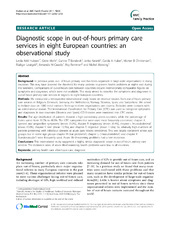| dc.description.abstract | Background: In previous years, out- of-hours primary care has been organised in large-scale organisations in many countries. This may have lowered the threshold for many patients to present health problems at nights and during the weekend. Comparisons of out-of-hours care between countries require internationally comparable figures on symptoms and diagnoses, which were not available. This study aimed to describe the symptoms and diagnoses in out-of-hours primary care services in regions in eight European countries. Methods: We conducted a retrospective observational study based on medical records from out-of-hours primary care services in Belgium, Denmark, Germany, the Netherlands, Norway, Slovenia, Spain, and Switzerland. We aimed to include data on 1000 initial contacts from up to three organisations per country. Excluded were contacts with an administrative reason. The International Classification for Primary Care (ICPC) was used to categorise symptoms and diagnoses. In two countries (Slovenia and Spain) ICD10 codes were translated into ICPC codes. Results: The age distribution of patients showed a high consistency across countries, while the percentage of males varied from 33.7% to 48.3%. The ICPC categories that were used most frequently concerned: chapter A ‘general and unspecified symptoms’ (mean 13.2%), chapter R ‘respiratory’ (mean 20.4%), chapter L ‘musculoskeletal’ (mean 15.0%), chapter S ‘skin’ (mean 12.5%), and chapter D ‘digestive’ (mean 11.6%). So, relatively high numbers of patients presenting with infectious diseases or acute pain related syndromes. This was largely consistent across age groups, but in some age groups chapter H (’ear problems’), chapter L (’musculoskeletal’) and chapter K (’cardiovascular’) were frequently used. Acute life-threatening problems had a low incidence. Conclusions: This international study suggested a highly similar diagnostic scope in out-of-hours primary care services. The incidence rates of acute life-threatening health problems were low in all countries. | en_US |

